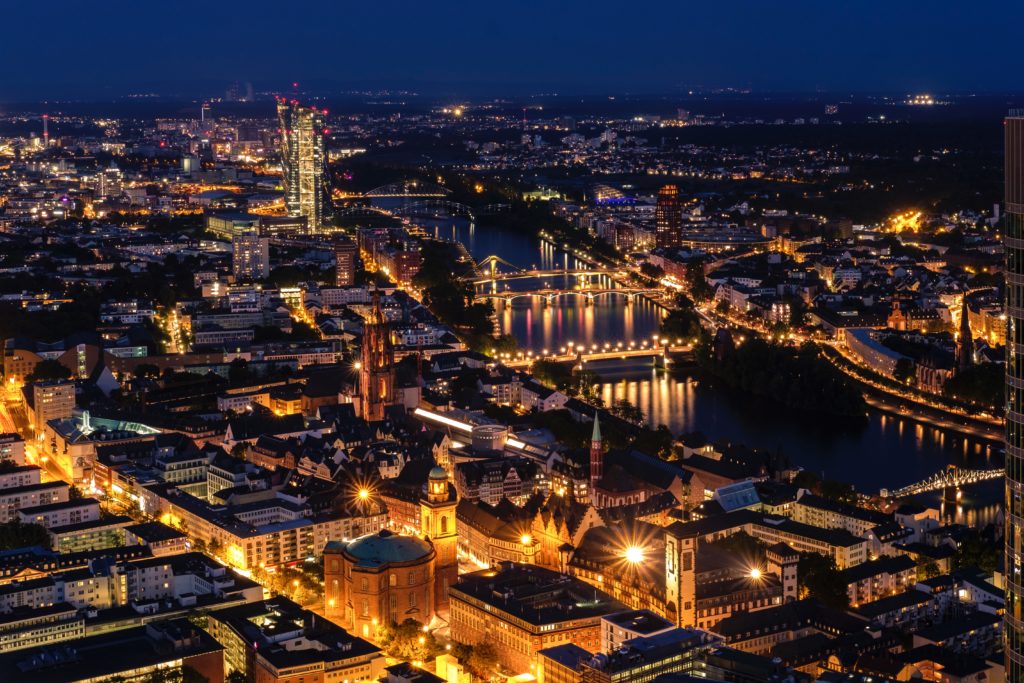Across Europe, information and communication technologies are optimizing clean-energy systems by making them more connected, intelligent, efficient, reliable, and cheaper. Germany and France lead the pack.

Virtual power plants optimize supply and demand of green energy to flexibilize the energy infrastructure. (Photo by Bruno Glätsch, CC BY-SA 4.0)
When most people think of clean energy systems, they usually conjure up images of soaring wind turbines, solar panels, or electric-vehicle fleets. Yet a key element of the systems of the future, and reality right now in Europe, is not apparent to the naked eye: the energy management technology that collects and then feeds clean-energy bundles into smart power grids. These systems direct electricity to where it’s needed, when it’s needed, by aggregating data and communicating at nano speed between energy sources, prosumers (actors who both consume and produce energy), flexumers (subjects active in the energy system), and grid operators. In a very short time, they’ve become ever more involved in the balancing of highly complex, weather-dependent transmission grids.
Information and communication technologies (ICT) are key to an increasingly energy-efficient, decentralized, and flexible energy infrastructure. This kind of digital energy management can help cut GHG emissions, save consumers money, and balance the energy system, greatly speeding up the pace of the clean energy transition.
The kind of actors involved in this state-of-the-art transformation are virtual power plants like France’s Voltalis and Germany‘s Next Kraftwerke, which bring together the generation sources of tens of thousands of energy producers, bundle these resources, and sell them to grid operators or energy markets in the volumes that they need it, when they need it. Voltalis, founded in 2006, is the world’s largest virtual power plant with 900 MW of power under contract through 100,000 members. It is connected to nearly one million devices across Europe. Next Kraftwerke, a Cologne start-up, networks thousands of electricity producers, consumers, and storage facilities. Using an algorithm, NextKraftwerke “collects and merges data from a variety of sources: operational data from the virtual power plant, current weather and grid data, and live market data.” This accumulated data, combined with technology and market experience, makes it specialists for day-ahead, intraday, and control reserve markets, according to its website.
The balancing, or as it’s called optimizing, of supply and demand in a system based on intermittent renewables is at the crux of the digital revolution. Of course, ever more generation in the form of decentralized wind farms and photovoltaic systems are being connected to the power grid. This means that there will be times, when the wind doesn’t blow and the sun doesn’t shine, thus leaving supply uncovered. And there are times when there’s too much sun and wind-produced energy for the system to absorb – and nowhere for it to go.
The matching of supply and demand in such a system is called balancing, and the smart grid, which is getting ever smarter, can cover a lot of balancing, shifting clean energy from locations of surplus to locations where energy is needed.
But as ever more different kinds of renewable energy and demand response markets play into the mix – and as electrification of transportation and energy increases, and as smart meters become ever more common – the smart grid can’t optimally integrate all of these elements into one, fluid system. The copper (that’s the grid) needs help!
This is where digitization offers a great opportunity for the energy transition: the management of supply and demand before it enters the grid. Storage, demand management, energy efficiency optimalization, the integration of sectors, prosumer bundling – these elements can be networked together with smart technology that make the system as a whole more flexible – in other words, that make it work.
“Digital technology is the catalyst that will allow the sector to ready the power system for the future,” according to a McKinsey consulting firm report. “Intelligent feed-in points, smart devices, and smart storage solutions will help uncouple demand from supply, while digital trading platforms will enable the system to handle and distribute a growing power load in ever smaller increments.”
The more controllable energy generation plants and the more flexible consumption points become part of the power and heat supply, the faster and better individual players must communicate with each other. The nationwide installation of intelligent metering systems, known as smart meters, will add to this, as will the integration of e-cars and heat and cooling pumps, smart homes and industries, peer-to-peer energy trading, among other ways that we all become prosumers and flexumers – not just those with solar panels.
Simply put, homes and businesses where cars are plugged in start to become more “interactive,” opening up a potentially large source of flexibility in the power system that didn’t exist before. “This is arguably one of the big synergies of our new energy paradigm,” explains Toby Couture, director of E3 Analytics, a German think tank. “The transition of the transport sector will ultimately end up helping and facilitating the transition in the power sector, enabling more renewables to be phased-in in a positive kind of feedback loop.“
Since beyond-cooper management is so new, regulators are still trying to catch up. Policymakers can spur its uptake by formulating energy market rules designed for fluid, peer-to-peer power trading. More regulators, for example, could approve permanent battery tariffs that pay prosumers for storing energy. More energy storage, customer-sited batteries, connected mini-grids, metered houses and buildings and, of course, more clean energy generation will facilitate the expansion of energy management services.
This isn’t science fiction, it’s how the Energiewende can work.